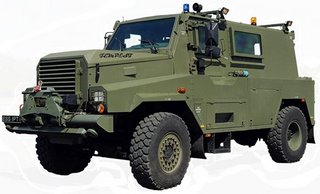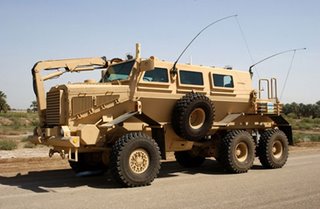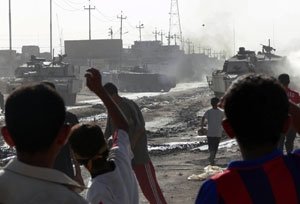 According to the Rt Hon Adam Ingram MP, minister of state for defence, "we take all measures possible to ensure the safety and security of our troops deployed in Iraq". This is in response to an MP who had passed on a constituent's letter (a former serving soldier) expressing concern about "the safety of so-called armoured Land Rovers".
According to the Rt Hon Adam Ingram MP, minister of state for defence, "we take all measures possible to ensure the safety and security of our troops deployed in Iraq". This is in response to an MP who had passed on a constituent's letter (a former serving soldier) expressing concern about "the safety of so-called armoured Land Rovers".On the face of it, Ingram's statement is an out-and-out lie, except that in the weasel words that flow so easily from the civil service, to be signed off by their ministers, there is an important qualifier, in the use of the word "possible".
To the ordinary person, that word might encompass every measure known to man, certainly anything technically feasible, but in the dark halls of Whitehall, it would also include the issue of "affordability". Straight out of "Yes Minister", you can almost hear their honeyed words: "There is nothing allocated in the budget, Minister, so acquiring enhanced protection for our troops is not possible".
From there it is an easy step to write to the public, grieving relatives, worried parents, MPs and the rest, telling them: "…we take all measures possible". In strict terms, it is not a lie – but then it is not the truth either.
However, as we research this issue more deeply, inevitably the labyrinthine complexity emerges and what seems at first sight a straightforward black-and-white question of providing better armoured vehicles for our troops merges into complicated arguments about tactics, procedures, training and capabilities.
It is in this grey area that ministers are able to operate, obfuscating the issues and confusing readers of their letters, in which manner does Ingram soothingly declare, "mitigation measures are not just about equipment – all our forces undergo a comprehensive package of pre-deployment training to ensure that they are as prepared as possible for the specific operational environment they will encounter".
The sub-text, of course, is that it is not just about spending more money. In fact, implies the minister, our superb training, etc., etc., will prevail. Carefully does he avoid telling us, however, how any amount of training will protect a soldier in a lightly armoured vehicle from the blast of a concealed IED, triggered by an unseen operator.
It is here, therefore, that we pick up on the emerging story, broached in our two previous posts, here and here, which – on the basis of what we have so far found out - seem to show up the British at their very best and their very, very worst.
 By way of background, we need to explore what is currently happening in the US-occupied areas of Iraq, where the scourge of the IED accounts for a full 68 percent of the battle casualties. To counter this threat, the Americans have been, since 2004 and now in increasing numbers, deploying new equipment, the Buffalo mine clearance vehicle (right) and the Cougar HEV/JERRV series (below left), together with the RG-31 series.
By way of background, we need to explore what is currently happening in the US-occupied areas of Iraq, where the scourge of the IED accounts for a full 68 percent of the battle casualties. To counter this threat, the Americans have been, since 2004 and now in increasing numbers, deploying new equipment, the Buffalo mine clearance vehicle (right) and the Cougar HEV/JERRV series (below left), together with the RG-31 series.Bear with me briefly on the technicalities, but the basic strategy is, acting as a team, these vehicles are sent out onto the roads of Iraq to hunt out mines and IEDs and to destroy them. Then, as a final stage before the any particular road is cleared to allow ordinary patrols down them, the Cougar travels down it in a process known as "route proving" – on the basis that, if there is anything there, the mine protected vehicle will take the hit and the crew will survive.
 Now, the thing is that this technique seems to have been pioneered not by the Americans but by the British in Bosnia, as early as 1999-2000. This is why the Mambas were purchased. But, even more intriguingly, it was there that the greater threat of the "penetrator mines" emerged, which led the development of British-funded counter-measures and the order of eight Cougar mine protected vehicles, in what is known as the Tempest project.
Now, the thing is that this technique seems to have been pioneered not by the Americans but by the British in Bosnia, as early as 1999-2000. This is why the Mambas were purchased. But, even more intriguingly, it was there that the greater threat of the "penetrator mines" emerged, which led the development of British-funded counter-measures and the order of eight Cougar mine protected vehicles, in what is known as the Tempest project.This, incidentally was in December 2001, in what appears to be the very first order for such vehicles, more than three years before the US forces placed their orders. Furthermore, the vehicles were upgraded to protect against the new mine threat. In other words, in a pioneering piece of research and development, we emerged with world-beating techniques and equipment, years before our more technically advanced cousins.
However, while the Americans have so far bought 122 Cougars - and have over a thousand more on order - we bought eight. I do not know yet whether they were deployed in Bosnia, but they do appear to have been sent to the Gulf, although I can find absolutely no reports of their having been used. According to one report, however, the vehicles are back in the UK being refurbished, prior to their despatch to Afghanistan where, it is claimed, the mine hazard is greater.
At a point, therefore, when the IED threat in the British occupied sector of Iraq is probably at its highest, the life-saving equipment pioneered by the British has been withdrawn, while the Americans are introducing it en masse, adopting precisely the tactics which our own Royal Engineers developed. You really could not make this up.
 In the meantime, I have been sent an extract from the Regimental Journal of the King's Royal Hussars, which gives a graphic account of their recent deployment to Iraq. From this emerges that the current tactics adopted – unwittingly – are brutal and primitive. Quite simply, the troops are told to patrol their areas in lightly armoured Land Rovers until one or more of them are blown up. Then the Land Rovers are withdrawn and replaced by Warriors and Challenger tanks, until it is deemed safe to resume patrolling in Land Rovers again.
In the meantime, I have been sent an extract from the Regimental Journal of the King's Royal Hussars, which gives a graphic account of their recent deployment to Iraq. From this emerges that the current tactics adopted – unwittingly – are brutal and primitive. Quite simply, the troops are told to patrol their areas in lightly armoured Land Rovers until one or more of them are blown up. Then the Land Rovers are withdrawn and replaced by Warriors and Challenger tanks, until it is deemed safe to resume patrolling in Land Rovers again.In effect – although they do so uncomplainingly – our soldiers are being used a "canaries down the mine" in a tactic redolent of the Red Army, in which punishment battalions were sent into minefields to clear the way for the assault troops.
 From a more strategic point of view, this means that the Army can no longer function effectively. While Warriors and Challengers do provide additional protection, as the King's Royal Hussars report testified, their use "caused a major change in the way the Squadron operated, limiting the distances we could cover and the routes we could use." At one point, movement in "Snatch" Land Rovers was "deemed too dangerous" in Al-Amarah and helicopters had to be used to lift fully crewed Land Rovers out to the Iranian border where the Squadron was responsible for conducting patrols.
From a more strategic point of view, this means that the Army can no longer function effectively. While Warriors and Challengers do provide additional protection, as the King's Royal Hussars report testified, their use "caused a major change in the way the Squadron operated, limiting the distances we could cover and the routes we could use." At one point, movement in "Snatch" Land Rovers was "deemed too dangerous" in Al-Amarah and helicopters had to be used to lift fully crewed Land Rovers out to the Iranian border where the Squadron was responsible for conducting patrols.Returning, therefore, to Mr Ingram's claim that "we take all measures possible to ensure the safety and security of our troops deployed in Iraq", clearly this is not the case. The equipment and techniques do exist and, since the US forces introduced them, their casualty rate from IEDs has halved.
The problem is that Mr Ingram does not have the money. The government is happy to commit £14 billion to the FRES programme, and billions more on other equipment to provide our component of the European Rapid Reaction Force but that leaves nothing extra for the forces in Iraq. To spend a few million on new kit for them is simply not "possible".
COMMENT THREAD